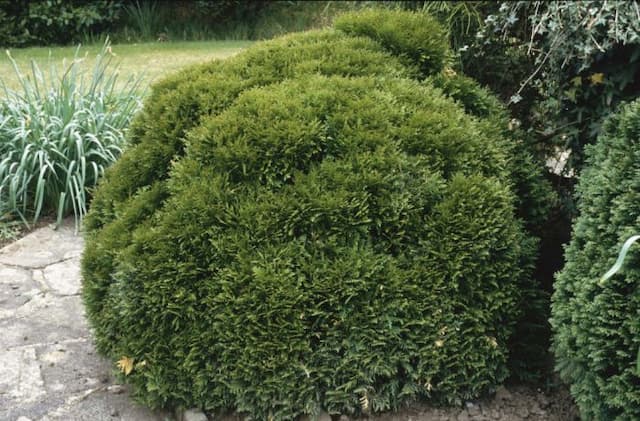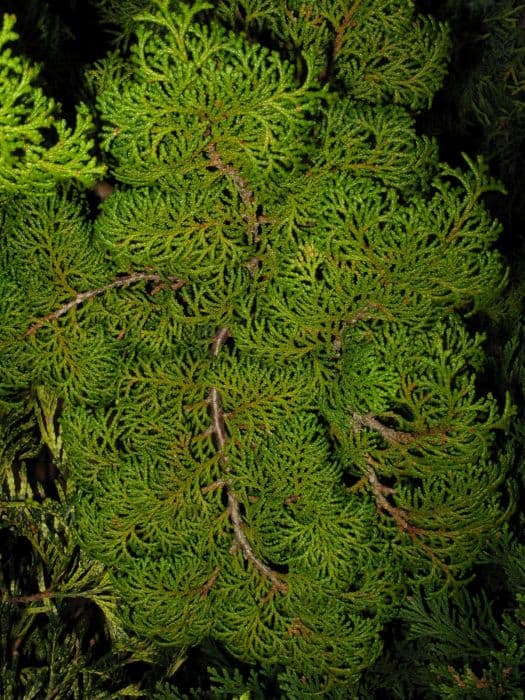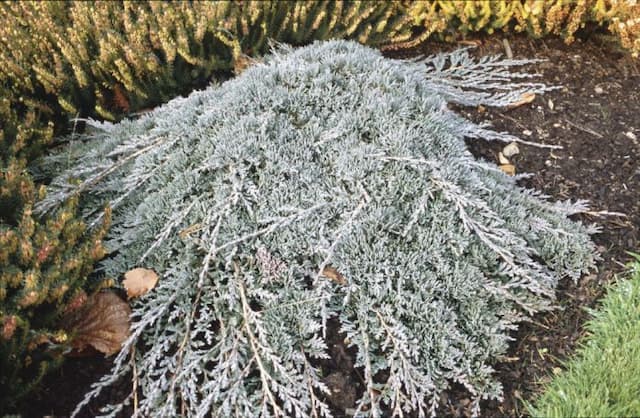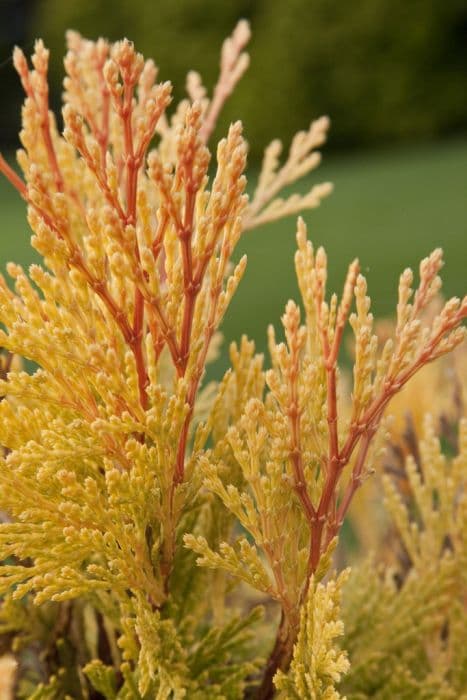Western red cedar Thuja plicata

ABOUT
Thuja plicata, more commonly known as the Western Red Cedar, is an evergreen coniferous tree that is admired for its striking appearance. It is characterized by its rich green, scale-like leaves which are glossy and aromatic when crushed. The foliage forms flat sprays with a pattern that resembles a herringbone. The leaves can vary in color from deep green to a lighter greenish-yellow depending on the variety and age of the plant. The Western Red Cedar has a distinctive reddish-brown bark which peels off in long strips, adding to its textured look. Its bark is also soft and fibrous, which makes it easily distinguishable from other trees. The tree produces small cones, which turn from green to brown as they mature. These cones are slender, about 1-2 cm long, and consist of 10-15 scales arranged in opposite pairs. The overall shape of the Western Red Cedar is pyramidal when young, which becomes more columnar as it matures. Its branches droop gracefully as the tree grows, contributing to its elegant stature. The tree’s symmetry and dense foliage make it a popular choice for ornamental planting, hedges, and screens. Its wood is also highly valued for its durability, resistance to decay, and aromatic properties.
About this plant
 Names
NamesFamily
Cupressaceae.
Synonyms
Western Redcedar, Pacific Redcedar, Giant Cedar, Shinglewood, Giant Arborvitae, Western Arborvitae, Canoe Cedar.
Common names
Thuja gigantea, Thuja lobbii, Thuja menziesii, Libocedrus plicata
 Toxicity
ToxicityTo humans
The Western Red Cedar contains compounds that can be toxic to humans if ingested. The symptoms of poisoning include gastrointestinal upset such as nausea, vomiting, diarrhea, and abdominal pain. Ingesting large quantities could lead to more severe issues such as muscle spasms, seizures, or damage to the liver.
To pets
In pets, the Western Red Cedar can be toxic if ingested. Symptoms of poisoning in animals might include drooling, vomiting, diarrhea, abdominal pain, and sometimes more serious neurological signs such as depression, seizures, or muscle weakness. It is crucial to prevent pets from ingesting this plant and to seek veterinary attention if they do.
 Characteristics
CharacteristicsLife cycle
Perennials
Foliage type
Evergreen
Color of leaves
Green
Height
70 feet 213 meters
Spread
15 feet 4.5 meters
Plant type
Tree
Hardiness zones
5
Native area
North America
Benefits
 General Benefits
General Benefits- Landscape Ornamentation: Western Red Cedar adds aesthetic appeal to gardens and landscapes with its lush, evergreen foliage.
- Privacy Screen: Its dense growth habit makes it ideal for creating privacy screens or hedges.
- Wind Break: The thick foliage also serves as a windbreak, protecting smaller plants and garden areas from strong winds.
- Noise Reduction: Western Red Cedar can help dampen noise when planted along roads or highways.
- Erosion Control: The plant's extensive root system helps to prevent soil erosion, especially on slopes or in areas with loose soil.
- Wildlife Habitat: Provides shelter and nesting sites for birds and other wildlife.
- Wood Production: Western Red Cedar is highly valued for its rot-resistant wood, which is used for construction, fencing, and shingles.
- Cultural Significance: Indigenous peoples of the Pacific Northwest have historically used the wood and bark of Western Red Cedar for various cultural purposes, including totem poles, canoes, and clothing.
 Medical Properties
Medical Properties- Antiviral: Thuja plicata contains compounds that may have antiviral effects.
- Antifungal: It has been traditionally used for its antifungal properties.
- Immunostimulant: The plant is sometimes used to stimulate the immune system.
- Respiratory health: It's been used in folk medicine for respiratory conditions.
- Anti-inflammatory: Thuja plicata may possess anti-inflammatory properties.
- Astringent: It has been used for its astringent qualities in traditional practices.
 Air-purifying Qualities
Air-purifying QualitiesThis plant is not specifically known for air purifying qualities.
 Other Uses
Other Uses- Boat Building: The wood of Western Red Cedar is highly valued in the creation of canoes, kayaks, and other small boats due to its durability, light weight, and resistance to decay.
- Musical Instruments: Craftsmen use the wood to make soundboards for instruments such as guitars and violins, as it has excellent tonal qualities.
- Animal Bedding: Shavings from Western Red Cedar are often used as bedding for small animals and horses because they have a pleasant scent and can deter pests.
- Beehives: The wood is a popular choice for constructing beehives, as it is naturally insulating and helps keep the hive at a stable temperature.
- Aromatherapy: The distinct and pleasant aroma of Western Red Cedar is sometimes incorporated into sachets and closet hangers as a natural moth repellent and to impart a fresh scent to clothing and linens.
- Culinary Smoking: Wood chips from the Western Red Cedar are used to smoke meats and fish, imparting a unique flavor to the food.
- Traditional Carving: Indigenous peoples of the Pacific Northwest use Western Red Cedar for carving totems, masks, and other ceremonial and cultural artifacts.
- Landscaping: Because of its natural beauty and tolerance for various climates, Western Red Cedar is often planted in gardens and parks for ornamental purposes.
- Rainwater Harvesting: The large, buttressed roots of the Western Red Cedar are sometimes employed in traditional rainwater harvesting techniques to channel water to where it is needed.
- Literature and Symbolism: The tree holds a significant place in Northwest Coast mythology and is often referenced in literary works that explore the region's natural history and culture.
Interesting Facts
 Feng Shui
Feng ShuiThe Western Red Cedar is not used in Feng Shui practice.
 Zodiac Sign Compitability
Zodiac Sign CompitabilityThe Western Red Cedar is not used in astrology practice.
 Plant Symbolism
Plant Symbolism- Longevity: Thuja plicata, commonly known as the Western Red Cedar, is known to live for hundreds of years, making it a symbol of durability and long life.
- Protection: The tree's durable, rot-resistant wood has been used by Native American cultures to build protective structures, making the plant a symbol of shelter and protection.
- Healing: Various parts of the Western Red Cedar have been used medicinally by indigenous peoples, symbolizing healing and health.
- Purity: The Western Red Cedar is often associated with purification due its clean, fresh scent and its use in cleansing rituals.
- Sanctity: With its presence in sacred spaces and its use in spiritual ceremonies, the Western Red Cedar represents holiness and the divine.
 Water
WaterWestern Red Cedar should be watered deeply and thoroughly to ensure that the root zone is well-saturated. For newly planted trees, water with about 15-20 gallons once a week during dry spells. After establishment, which typically takes a few months to a year, reduce watering to every two to three weeks, depending on weather conditions. During hot, dry periods, weekly watering may be necessary, whereas in cooler, wetter seasons, less frequent watering is required. Adjust watering to maintain moist but not soggy soil, and during winter, reduce watering since the plant will require less.
 Light
LightWestern Red Cedar thrives best in full sun to partial shade. Ideally, locate this plant in a spot where it receives at least four to six hours of direct sunlight a day. It can also tolerate full sun conditions throughout the day but is adaptable enough to grow well in partially shaded areas where it receives some respite from the intense midday sun.
 Temperature
TemperatureWestern Red Cedar can survive in a range of temperatures and is hardy to USDA zones 5 through 7. The ideal temperature range for growing Western Red Cedar is between 60°F to 70°F, but it can withstand temperatures as low as -20°F during dormant winter periods and can tolerate summer highs well into the 90°F range. Avoid planting in locations where temperature extremes are common or where winter temperatures frequently fall below -20°F.
 Pruning
PruningPruning Western Red Cedar is important to maintain its desired shape, remove dead or broken branches, and improve air circulation. The best time to prune this tree is in the late winter or early spring before new growth begins. Prune sparingly, as heavy pruning can damage the natural form and health of the tree. It's often sufficient to prune every two to three years to keep the tree looking tidy and to remove any undesirable growth.
 Cleaning
CleaningNot needed
 Soil
SoilWestern Red Cedar prefers a well-draining soil mix with a high organic content. A mix combining loam, peat moss, and perlite or coarse sand is ideal to ensure proper drainage and root aeration. Additionally, a slightly acidic to neutral pH range of 5.5 to 7.0 is optimal for this species.
 Repotting
RepottingWestern Red Cedar, being a larger landscape plant, is not typically repotted. Instead, it is planted directly into the ground where its root system can spread. Trees planted in containers may need repotting every few years to prevent root-binding and to replenish nutrients in the soil.
 Humidity & Misting
Humidity & MistingWestern Red Cedar thrives in moderate to high humidity environments, mimicking its native habitat in the Pacific Northwest. While it is adaptable to various levels of humidity, it does best with consistent atmospheric moisture, so aiming for a relative humidity of 40% or higher is beneficial.
 Suitable locations
Suitable locationsIndoor
Grow Western Red Cedar with bright light but not full sun.
Outdoor
Plant Western Red Cedar in moist, well-drained soil with mulch.
Hardiness zone
5-7 USDA
 Life cycle
Life cycleWestern Red Cedar (Thuja plicata) seeds require stratification—a period of cold to break dormancy—before germination, which occurs in spring under suitable moisture conditions. Seedlings develop a taproot and begin to establish a characteristic conical shape, growing rapidly in their early years. As saplings, they enter a vigorous growth phase, competing for light and space, and may live for many years in this juvenile state before becoming mature trees. Upon maturity, these trees begin reproductive cycling, producing small cones that release winged seeds to be dispersed by the wind. Mature Western Red Cedars can live for over a thousand years, with a slow growth rate in later stages of life. Old-age trees eventually fall victim to natural processes like disease, infestation, or environmental conditions, completing the life cycle.
 Propogation
PropogationPropogation time
Spring-Early Summer
The most popular method for propagating Western Red Cedar, or Thuja plicata, involves softwood cuttings. This technique is usually carried out in late spring to early summer, when new growth is soft and flexible. Cuttings should be taken from healthy parent plants, selecting shoots that are 4 to 6 inches (about 10 to 15 centimeters) long. The cut end is often dipped in a rooting hormone to encourage root development and then planted in a well-draining medium such as a mix of peat and sand. The cuttings need to be kept under high humidity, which can be achieved by covering them with a plastic dome or misting them regularly. After a few weeks to months, the cuttings should develop roots and can be transplanted into individual pots or outdoor locations.









